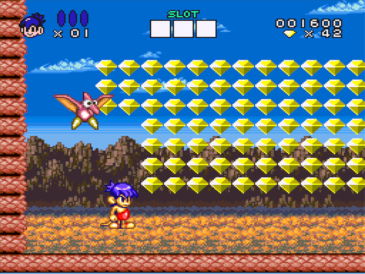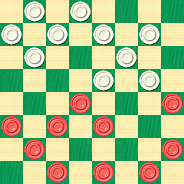The Checker Maven
Jump to navigationCapers on the Kelso: Part 3

What does a screenshot from an arcade-style video game have to do with checkers?
We challenge you to identify the source of the screenshot, for therein lies the answer.
We continue with our multi-part excursion into the Kelso with the third installment, taken from Willie Ryan's Tricks Traps & Shots of the Checkerboard. Today we cover the beginning of Willie's Variation 1.
The run-up is short:
10-15, 22-18, 15-22, 25-18.
Now we continue with Willie's text:
Variation 1
| 6-10---A | 8-15 | 9-13 |
| 29-25---B,3 | 25-22 | 23-18 |
| 11-15 | 4-8 | 7-11*---D |
| 18-11 | 21-17---C | 30-25 |

BLACK
Black to Play and Win
B:W32,31,28,27,26,25,24,22,18,17:B15,13,12,11,10,8,5,3,2,1.
A---"Black has three good moves to start with. Most of our leading masters have shown a preference for 9-13 here, but 6-10 (an earlier favorite) and 11-15 are just as good. The principal advantage of the text defense (6-10) is the fact that it may be applied also to another two-move opening: 9-13, 22-17, 13-22, 25-18, 6-9, which develops the same position.
B---Some players object to 6-10 at A because of the 18-14 'bust' at this juncture, and others dodge 6-10 because of the situation arising at C (21-17) in trunk. The analysis in this lesson is offered to prove that both objections are unfounded. See Variation 3 for play on 18-14.
C---This move has long been regarded as the major stumbling block of the 6-10 defense. My innovation at D deflates this highly rated attack.
D---This odd move improves on more published play than you can shake a stick at. The accepted move in the past has been 8-11, as used in the Stewart-Banks match, giving white a strong game. I had this 7-11 improvement cooked up for Walter Hellman at the 1939 Tacoma National Tourney, but he avoided the whole line by playing 18-14 at B."
3---Variation 3 will be the subject of a future column---Ed.
Click on Read More to see the solution and additional notes.![]()
Solution

BLACK
Black to Play and Win
B:W32,31,28,27,26,25,24,22,18,17:B15,13,12,11,10,8,5,3,2,1.
The correct move is 26-23. Willie continues (his Note E in the book):
"An innocent might try 30-25, at which point black will beat him with: 10-14, 17-10, 13-17, 22-13---1. If 27-23 is used, then 5-9, 24-20* (not 23-19, 2-7, 26-23, 1-5, 24-20, 15-24, 28-19, 10-15, 19-10, 7-21, 32-27, 9-14, etc., or black will win---4), 1-5, 28-24, 9-14, 18-9, 5-21, 23-19, 2-6, 26-23, 3-7, will form the position on diagram at Note F---2."
1---Play continues 15x29 26-23 2-7 31-26 7x14 and Black wins---Ed.
2---To appear next in the series---Ed.
4---This is actually a draw: 27-24 17. 11-15 31-26 and now Black must give the man back. White threatens a 2 for 1 with 23-18 and Black's only option is 13-17 22-13 15-18 23-19 etc. to a draw. Willie should have taken it a couple of moves farther!---Ed.
The game screenshot? It's from the popular Nintendo game Congo's Caper.
You can email the Webmaster with comments on this article.
